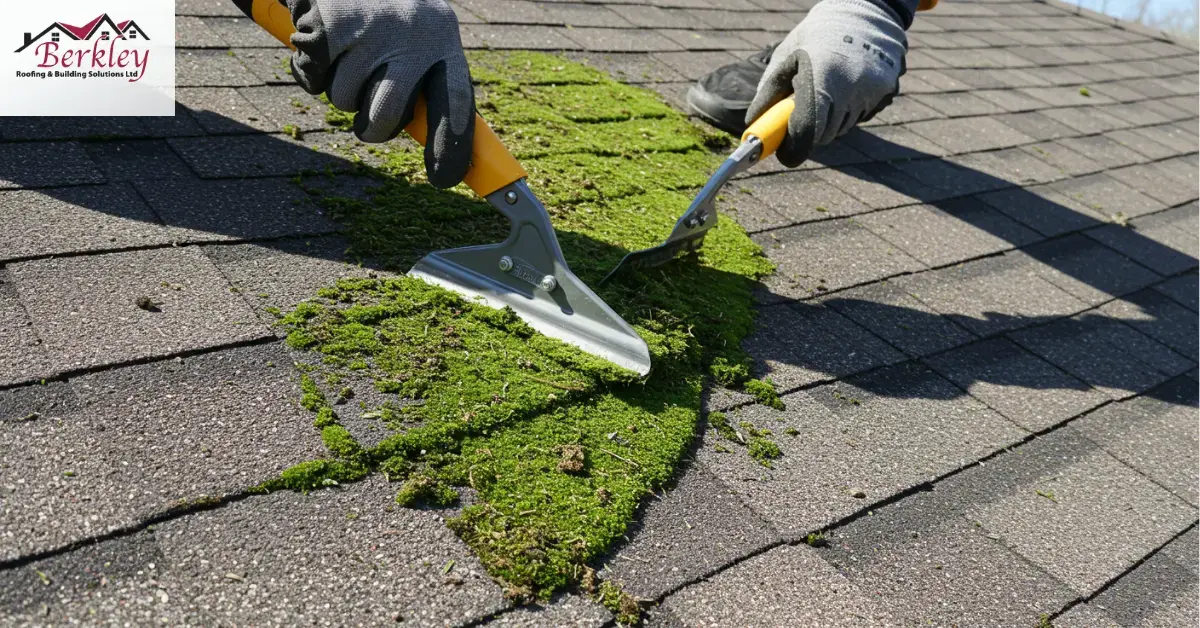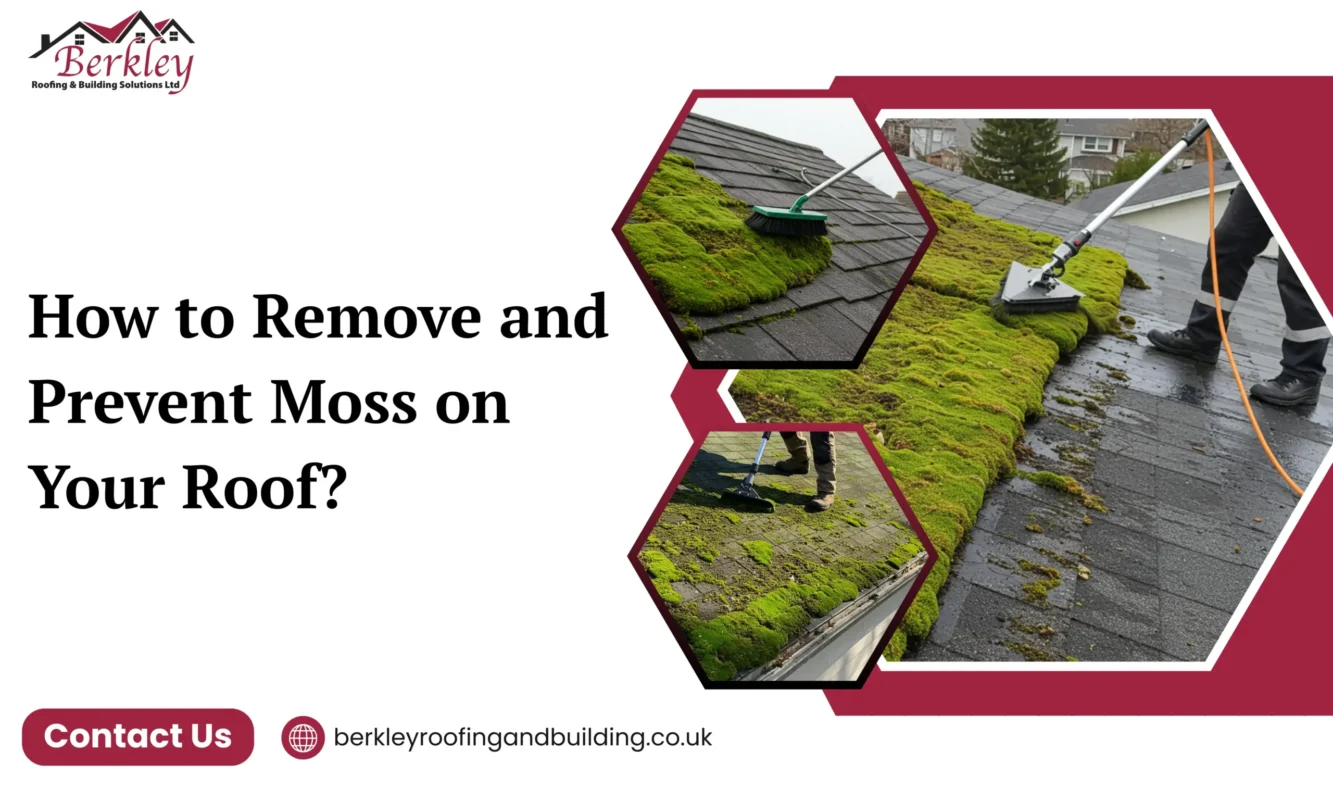Moss growing on a roof might seem like a small issue, but over time, it can cause serious damage. It holds moisture against the surface, weakens shingles or tiles, and can cause leaks or even structural problems.
But the best part is that you don’t need to be a roofing expert to remove it. With the right tools, some safety tips, and step-by-step instructions, you can remove moss from your roof and prevent it from coming back.

How to Remove Moss From Roof? A Step-by-Step Guide
Removing moss from your roof isn’t too complicated, and you can do it yourself with caution and patience.
Step 1: Choose a Dry Day
Moss removal from roof should always be done on a dry and calm day, without rain, strong winds, or excessive moisture. Avoid working early in the morning when there might still be dew on the roof. Make sure the surface is completely dry before you start brushing or spraying.

Step 2: Wear the Safety Gear
Before climbing up, make sure you’re properly dressed for the work. Wear rubber-soled shoes or boots, which give you a better grip on the roof. Gloves and protective goggles are also important to keep your hands and eyes safe from debris or cleaning spray. If your roof is sloped or particularly high, consider using a safety harness or rope to prevent falls. Moreover, use a sturdy ladder, and if possible, have someone hold it for you while you climb. Safety should always come first when working at heights.

Step 3: Gently Brush off the Moss
Once you’re on the roof, use a soft-bristle brush or broom to gently sweep off the moss. Always work from the top down, moving along the slope of the roof. Brushing upward can lift shingles or damage tiles, so be extra gentle. The point is to remove as much moss as possible without harming the roofing material. Avoid using a pressure washer; it might seem like a quick fix, but it can damage shingles, strip protective coatings, and even force water under your roof.

Step 4: Apply a Moss Removal Solution
After brushing, there will likely be some moss spores or roots left behind. To completely kill the moss and stop it from coming back too soon, apply a moss cleaner. You can choose a store-bought solution made specifically for roofs, or make your own using simple ingredients like white vinegar or bleach.

Commercial Moss Remover
- Spray the moss remover evenly over affected areas.
- Let it sit for 15–20 minutes, or as instructed on the label.
- Once the moss turns brown and dies, gently brush off any remaining debris.
Most commercial products are made to be safe for your roof, but always double-check that they are suitable for your roof material, such as asphalt shingles, tile, etc.
DIY Roof Moss Cleaning Solution
You can make your own moss killer with things you already have at home. However, if you use bleach, rinse any metal gutters, flashing, or siding nearby to prevent corrosion.
Two common recipes:
- White Vinegar + Water (50/50 mix)
- Bleach + Water (1 part bleach to 3 parts water)
How to use:
- Pour your solution into a spray bottle or garden sprayer.
- Spray directly onto moss-covered areas. Avoid spraying plants, as bleach and vinegar can harm them.
- Let the solution sit for 15–30 minutes.
- Afterward, gently scrub the area with a soft brush if needed.
How to Prevent Moss on Roof?
If you notice moss growing on roof areas repeatedly, it’s time to look at long-term solutions. Moss grows best in damp, shaded areas, so the key to prevention is keeping your roof dry, clean, and exposed to sunlight as much as possible. Here are some simple ways to do that:
Trim Overhanging Branches
If you have trees near your house, make sure to trim any branches that hang over the roof. Shade from trees creates the perfect environment for moss to grow. By letting more sunlight reach your roof, you make it harder for moss to survive. Plus, trimming branches also stops leaves from falling and building up on your roof.
Keep Gutters and Roof Clean
Leaves, twigs, and dirt can trap moisture on your roof, which encourages moss to grow. To prevent this, regularly clean your roof and gutters, especially in the fall when trees shed the most leaves. Keeping everything clear allows rainwater to drain properly and helps your roof stay dry.
Install Zinc or Copper Strips
Using zinc or copper strips is one of the most effective methods of moss prevention on roof surfaces. When it rains, tiny amounts of these metals wash down your roof and create a surface that moss doesn’t like. You can buy zinc or copper strips from a hardware store and install them near the top edge of your roof. Over time, this can help keep your roof moss-free without cleaning it regularly.
Schedule Yearly Roof Inspections
Even if everything looks fine from the ground, it’s always a good idea to check your roof once a year. A quick inspection can help you catch moss before it spreads and becomes harder to remove.
Apply Moss Prevention Sprays
There are special sprays made to prevent moss from growing. These treatments are easy to use and can last a year or more. Simply spray the product across your roof after cleaning, and reapply every 1–2 years, depending on the instructions. This extra layer of protection helps keep moss from coming back.

Conclusion
Taking the time to properly remove and prevent Moss on Your Roof and prevent it from growing back is well worth the effort. With the right safety steps, tools, and a bit of patience, you can clean your roof easily. By keeping your roof and gutters clean, trimming back shady branches, and using moss-prevention products, you can stop moss from coming back and save yourself future hassle. However, if your roof is badly damaged by moss, then we recommend hiring professional roofers in Muswell Hill to do that job.
FAQs
What is the safest moss remover for roofs?
Store-bought moss removers labeled “roof-safe” or a DIY mix of white vinegar and water are good options. Avoid harsh chemicals if you have nearby plants or metal fixtures.
How often should I clean moss off my roof?
It depends on your environment, but checking and cleaning your roof once a year is usually enough. Homes in shaded or damp areas may need more frequent attention.
How do zinc or copper strips prevent moss?
When it rains, small amounts of metal wash down the roof, creating a surface where moss can’t grow. They’re an easy, long-lasting way to prevent moss buildup.
Will removing moss damage my roof?
If done gently with the right tools (like a soft brush), moss removal won’t harm your roof. Avoid scraping hard or using high-pressure water.

